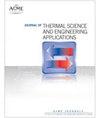大功率射频芯片阵列用氮化铝HTCC衬底的嵌入式微流控冷却
IF 1.4
4区 工程技术
Q3 ENGINEERING, MECHANICAL
引用次数: 0
摘要
射频电子技术正朝着大功率、高集成度和高功率密度的方向发展,导致热流通量不断增加。传统的大功率射频封装通常由氮化铝(AlN)衬底、铝硅外壳和铝合金冷板组成,由于界面过多,导热路径长,散热能力差,厚度高。本文为了提高射频电子器件的散热能力,减小射频电子器件的厚度,将微通道从冷板转移到AlN HTCC基板上,起到电气连接、结构支撑和液冷冷板的作用。首先设计了嵌入式AlN微通道冷却器。然后,制作了具有64个模拟芯片阵列和微通道的AlN衬底原型,并利用实验装置对其热性能进行了评估。最后,通过CFD仿真比较了该冷却器与传统冷却器的热性能。结果表明,与传统的冷却结构相比,所提出的嵌入式冷却结构的散热能力提高了61%,封装厚度减少了40%。本文章由计算机程序翻译,如有差异,请以英文原文为准。
Embedded Microfluidic Cooling in Aluminum Nitride (AlN) HTCC Substrate for High-power RF Chip Array
Radio frequency (RF) electronics are developing towards high power, high integration, and high-power density, resulting in a continuous increase in heat flux. The traditional high-power RF package, which is usually composed of aluminum nitride (AlN) substrate, aluminum silicon housing shell, and aluminum alloy cold plate, exhibits poor heat dissipation ability and high thickness due to excessive interfaces and a long thermal conduction path. In this paper, aimed at improving heat dissipation ability and reducing the thickness of RF electronics, the microchannel was transferred from the cold plate to the AlN HTCC substrate which plays the role of electrical connection, structural support, and liquid cooling cold plate. The embedded AlN microchannel cooler was firstly designed. Then, a prototype of the AlN substrate with 64 simulated chip arrays and microchannels was fabricated and the thermal performance was evaluated using an experimental setup. Finally, the thermal performances of the proposed and traditional cooler were compared using a CFD simulation. The results indicated that the proposed embedded cooling structure could enhance the heat flux dissipation ability by 61% and reduce the packaging thickness by 40% compared with the traditional cooling structure.
求助全文
通过发布文献求助,成功后即可免费获取论文全文。
去求助
来源期刊

Journal of Thermal Science and Engineering Applications
THERMODYNAMICSENGINEERING, MECHANICAL -ENGINEERING, MECHANICAL
CiteScore
3.60
自引率
9.50%
发文量
120
期刊介绍:
Applications in: Aerospace systems; Gas turbines; Biotechnology; Defense systems; Electronic and photonic equipment; Energy systems; Manufacturing; Refrigeration and air conditioning; Homeland security systems; Micro- and nanoscale devices; Petrochemical processing; Medical systems; Energy efficiency; Sustainability; Solar systems; Combustion systems
 求助内容:
求助内容: 应助结果提醒方式:
应助结果提醒方式:


